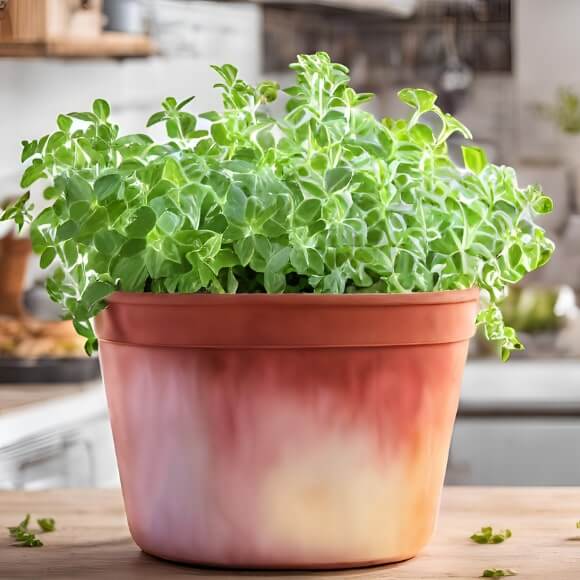Oregano (Origanum vulgare) is a hardy, aromatic herb known for its warm, earthy flavor and its essential role in Mediterranean cuisine. Often called “wild marjoram,” oregano is celebrated not only for its culinary uses but also for its medicinal properties. Rich in antioxidants and anti-inflammatory compounds, oregano has been traditionally used to support digestion and boost immunity. Easy to grow and versatile in cooking, oregano is a great choice for any garden, providing both beauty and flavor.

Soil Requirements
Oregano prefers well-draining soil with a neutral to slightly acidic pH, ideally between 6.0 and 7.0. It thrives in poor to moderately fertile soil, as overly rich soil can lead to reduced flavor intensity. Sandy or loamy soil works well for oregano, as it promotes drainage and prevents root rot.
Sun Requirements
Oregano is a sun-loving plant that needs full sunlight for at least six to eight hours a day to develop its characteristic flavor. Full sun not only enhances the herb’s growth but also intensifies its essential oils, which give oregano its distinctive aroma and taste. In hotter climates, a bit of afternoon shade can prevent leaf scorching.
Watering Requirements
Oregano is relatively drought-tolerant once established, making it an ideal choice for low-maintenance gardens. Water oregano deeply but infrequently, allowing the soil to dry out between waterings. Overwatering can lead to root issues, so it’s essential to avoid overly wet soil. During especially hot or dry spells, a little extra water will keep the plant happy, but generally, oregano does not require much fuss.
Best Plant Hardiness Zones
Oregano is hardy in USDA Zones 5 through 10, with some varieties able to withstand even cooler temperatures. In colder zones, it can be grown as an annual or brought indoors during the Winter. Perennial in warmer climates, oregano will return each year, growing more robust and flavorful with each season.
Popular Oregano Varieties
Oregano is a popular and adaptable herb, with many varieties that offer unique flavors and textures. Each variety brings something different to the table, allowing for diverse uses in cooking and herbal remedies. Here’s an overview of five popular types of oregano, along with tips on how to use each variety.
Greek Oregano
Greek oregano is perhaps the most well-known and widely used oregano variety. It’s highly aromatic and has a strong, peppery flavor, making it ideal for Mediterranean dishes. Greek oregano’s leaves are small, dark green, and packed with essential oils, which give it a bold, spicy kick.
Greek oregano is perfect for Italian and Greek cuisine, commonly used in pasta sauces, pizza, and marinades. Its intense flavor holds up well in cooked dishes, making it a popular choice for roasted meats and vegetables. Fresh or dried, Greek oregano is a staple in any kitchen, especially for traditional Mediterranean recipes like souvlaki and moussaka.
Italian Oregano
Italian oregano is a cross between oregano and marjoram, giving it a milder, sweeter flavor than Greek oregano. This variety is less pungent, with a delicate taste that pairs well with a wide range of dishes. Italian oregano has soft, green leaves and is often favored by those who find Greek oregano too intense.
Italian oregano is wonderful in tomato-based sauces, where its gentle flavor can shine without overpowering other ingredients. It’s a favorite for Italian dishes like pasta, lasagna, and caprese salad. Italian oregano’s subtle sweetness also makes it a good choice for salads and lighter recipes, for a touch of herbal flavor without too much spice.
Mexican Oregano
Mexican oregano is technically not part of the oregano family but is commonly used as a culinary substitute for Mediterranean oregano. Native to Mexico, this plant is actually related to lemon verbena, and it has a strong, citrusy, and slightly earthy flavor. Mexican oregano is a popular herb in Latin American and Southwestern cuisine, offering a unique twist on traditional oregano.
Mexican oregano is a must for Mexican and Tex-Mex dishes, such as chili, tacos, and enchiladas. Its bold flavor holds up well to spicy and robust ingredients, making it perfect for salsas, sauces, and stews. Mexican oregano pairs beautifully with cumin, garlic, and chili peppers, adding a bright, citrusy note to savory dishes.
Golden Oregano
Golden oregano is a striking variety with bright golden-yellow leaves. Although it has a milder flavor than Greek oregano, it adds a lovely visual element to the garden or plate. Golden oregano is often used as an ornamental plant due to its vibrant foliage, but it also serves as a culinary herb.
Golden oregano is a versatile addition to light dishes, such as salads, sandwiches, and herb butters, where its mild flavor can complement other ingredients without overpowering them. Its colorful leaves also make it a beautiful garnish for soups, stews, and roasted dishes. While not as intense in flavor as other varieties, golden oregano adds subtle flavor and visual appeal to meals.
Cuban Oregano
Cuban oregano is another plant that’s not a true oregano, but it shares a similar flavor profile. This tropical herb has thick, fleshy leaves and a strong, pungent aroma that’s a mix of oregano and thyme. Cuban oregano is more commonly grown as a houseplant but can be used as a culinary herb, especially in Caribbean and Indian cooking.
Cuban oregano is excellent for hearty dishes that benefit from its bold flavor, such as stews, curries, and roasted meats. It’s also used as a flavoring in Caribbean dishes like jerk chicken and Indian chutneys. Due to its strong flavor, Cuban oregano is best used in small amounts, and it can substitute for oregano or thyme in recipes that call for a robust herb. ❖


 Previous
Previous

